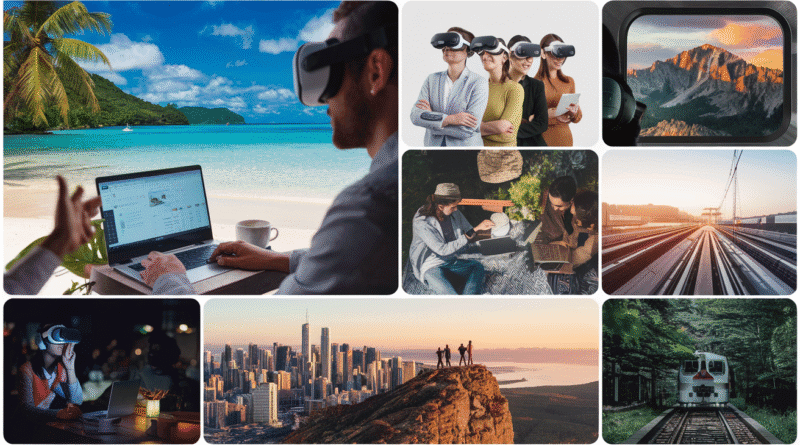10 Incredible Insights into the Blended Travel Boom: Work and Leisure Combined in the Post-Pandemic Era
Blended travel, also known as « bleisure, » has gained significant traction following the COVID-19 pandemic. As companies adapted to remote work during global lockdowns, many professionals realized they could work from virtually any location. This led to a growing trend where individuals combine work and leisure into a single trip, allowing them to balance productivity with exploration.
In the post-pandemic world, this trend has only accelerated, as people seek to optimize their work-life balance, extend travel experiences, and discover new destinations while remaining productive. The rise of bleisure marks a fundamental shift in how we approach both work and travel, creating new opportunities for professionals and businesses alike.
What is Work and Leisure Travel?
Work and leisure travel, or bleisure, refers to the practice of merging business and leisure in a single trip. Instead of traveling solely for work or vacation, individuals now extend business trips for leisure or work remotely from vacation destinations. This trend has been driven by the widespread adoption of remote work, enabling professionals to stay connected from anywhere with internet access.
Post-pandemic, bleisure has evolved beyond simply adding a few extra days to a work trip. Now, it’s about seamlessly blending workdays with travel, often spanning weeks or even months. Digital nomads and remote workers are increasingly working from beachfronts, mountain retreats, or cozy cafés in foreign cities. The flexibility of remote work has redefined the concept of travel.
Why Has Bleisure Become So Popular?
The pandemic reshaped how people think about work, proving that productivity is not confined to an office. With the rise of remote work, many individuals realized they could meet their professional responsibilities while exploring new destinations. The growing appeal of work-leisure travel can be attributed to several factors:
- Remote work flexibility: Many companies now offer flexible work arrangements, allowing employees to work from different locations while staying productive.
- Extended stays: Travelers are extending their stays at destinations for days or even weeks, combining work with leisure activities during their downtime.
- Changing work culture: As remote and hybrid work models become permanent, professionals have more freedom to work from vacation spots or other destinations.
- Focus on mental health: With a renewed emphasis on mental well-being, blending work and leisure has become a popular way to avoid burnout and maintain a healthy work-life balance.
Key Characteristics of Bleisure
Bleisure travel is more than simply adding extra days to a work trip—it reflects a deeper change in how people balance work and travel. Key characteristics of this trend include:
- Longer stays: Remote work flexibility allows travelers to extend their trips, sometimes staying for weeks or months at their destinations.
- Work-friendly spaces: The availability of co-working spaces, hotel business centers, and reliable Wi-Fi in vacation rentals has made it easier to work from various locations while staying productive.
- Purposeful travel: For many, blending work and leisure is about experiencing new cultures and environments, enhancing well-being while staying connected to work.
- Custom travel packages: Hotels, resorts, and travel agencies are increasingly offering packages designed for work-leisure travelers, combining professional amenities with leisure options.
Popular Bleisure Destinations
While bleisure travelers can work from virtually anywhere, certain locations have become particularly popular due to their infrastructure, amenities, and lifestyle offerings. These destinations strike the perfect balance between work and play:
- Bali, Indonesia: Known for its picturesque beaches, affordable living, and strong digital nomad community, Bali is a favorite among remote workers.
- Lisbon, Portugal: With its vibrant culture, charming streets, and growing number of co-working spaces, Lisbon is a top choice for blending work and leisure in Europe.
- Mexico City, Mexico: Offering rich cultural experiences and reliable internet, Mexico City is an attractive option for remote professionals.
- Barcelona, Spain: A well-connected city with plenty of work-friendly cafés, Barcelona combines rich history, stunning architecture, and a warm climate.
- Cape Town, South Africa: Known for its natural beauty and outdoor activities, Cape Town offers a scenic backdrop for work-leisure travelers.
The Future of Bleisure: What’s Next?
As remote work becomes a permanent fixture for many companies, the trend of work-leisure travel is expected to grow. The appeal of combining work and travel, particularly for younger generations like Millennials and Gen Z, will continue to influence how we approach both.
In the future, we can expect:
- More digital nomads: With greater flexibility, more professionals may embrace a digital nomad lifestyle, traveling frequently while maintaining their careers.
- Business travel merging with leisure: As companies offer more flexible work options, traditional business trips will increasingly transform into work-leisure journeys.
- Remote work-friendly destinations: Tourism boards and businesses will continue to market destinations with the necessary infrastructure for remote work, offering co-working spaces, reliable internet, and work-friendly amenities.
- Workation packages: Hotels and resorts will likely offer more « workation » packages, combining work-related facilities with opportunities for relaxation and exploration.
Tips for Planning a Successful Work and Leisure Trip
For those looking to embrace the work-leisure travel trend, careful planning is essential to ensure a productive and enjoyable experience. Here are some tips to make the most of your trip:
- Choose the right destination: Ensure your destination offers reliable internet, co-working spaces, and the amenities you need to stay productive.
- Balance work and leisure: Set clear boundaries to maintain a balance between work tasks and leisure activities.
- Stay organized: Use productivity tools to manage work while traveling and keep track of deadlines.
- Pack smart: Make sure you bring all your essential work equipment, as well as leisure gear to enjoy your downtime.
Conclusion: A New Era of Work and Travel
Blended travel represents a significant shift in how we approach both work and leisure. In a post-pandemic world, it has allowed professionals to redefine their work-life balance, combining the best aspects of both. Whether working from a beach in Bali or a café in Lisbon, this new approach to travel offers a lifestyle that merges productivity with adventure, enhancing mental well-being and enriching life experiences. As the trend continues, we can expect to see more opportunities for professionals to work remotely while exploring the world.

